Slides 📊
4.3. Conditional Probability
With the foundations of probability established, we can now extend our toolset to explore how events influence each other. In real-world scenarios, we often have partial information about an experiment’s outcome, and need to update our probability assessments as more information is gathered. Conditional probability provides the mathematical framework for incorporating this new information and analyzing relationships between events.
Road Map 🧭
Define conditional probability and understand its interpretation.
Derive the conditional probability formula and the general multiplication rule.
Understand how tree diagrams represent conditional probabilities graphically.
4.3.1. Understanding Conditional Probability
Conditional probability addresses how the probability of one event changes when we know that another event occurs. It represents the revised probability assessment for an event based on new information.
For example, suppose an AI model is built to detect wolves in an image. If it also received input that the image contains large carnivores, then it would assign a higher probability to the presence of wolves than without this prior information. This additional information changes, or conditions, the probability assessment.
Definition and Notation
The conditional probability of event \(A\) given that event \(B\) occurs is denoted by \(P(A|B)\), read as “the probability of \(A\) given \(B\).”
The conditional probability is computed as
This formula is valid only when \(P(B) > 0\); we cannot condition on impossible events, and we cannot divided by \(0\) to obtain a valid probability.
What is happening in the conditional probability formula?
A probability, whether conditional or not, represents the relative size of a part out of a whole.
In non-conditional situations, the relative size of event A is assessed out of the whole sample space.
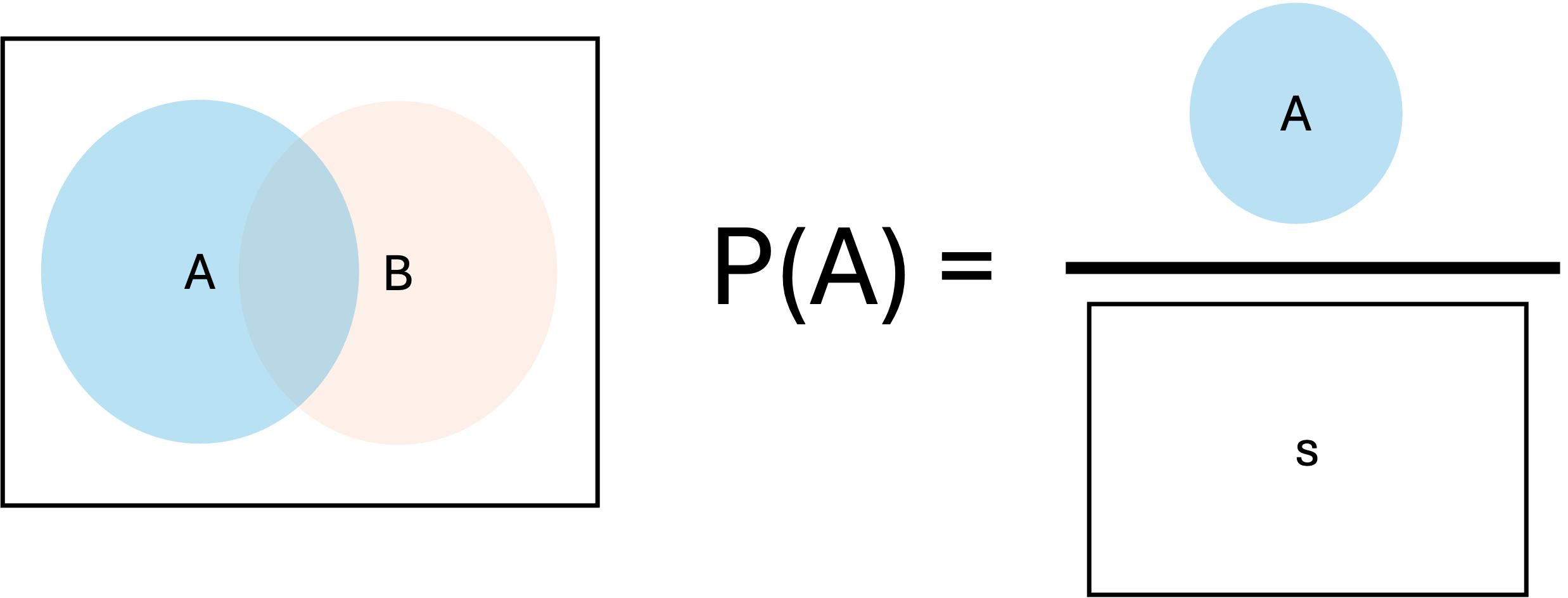
Fig. 4.11 Non-conditional probability
However, by knowing that event \(B\) occurs, our sample space becomes restricted to only the outcomes in \(B\) —anything that does not belong to \(B\) is not a possibility anymore. Within this reduced sample space, we’re interested in the relative size of the regoin which still belongs to event \(A\).
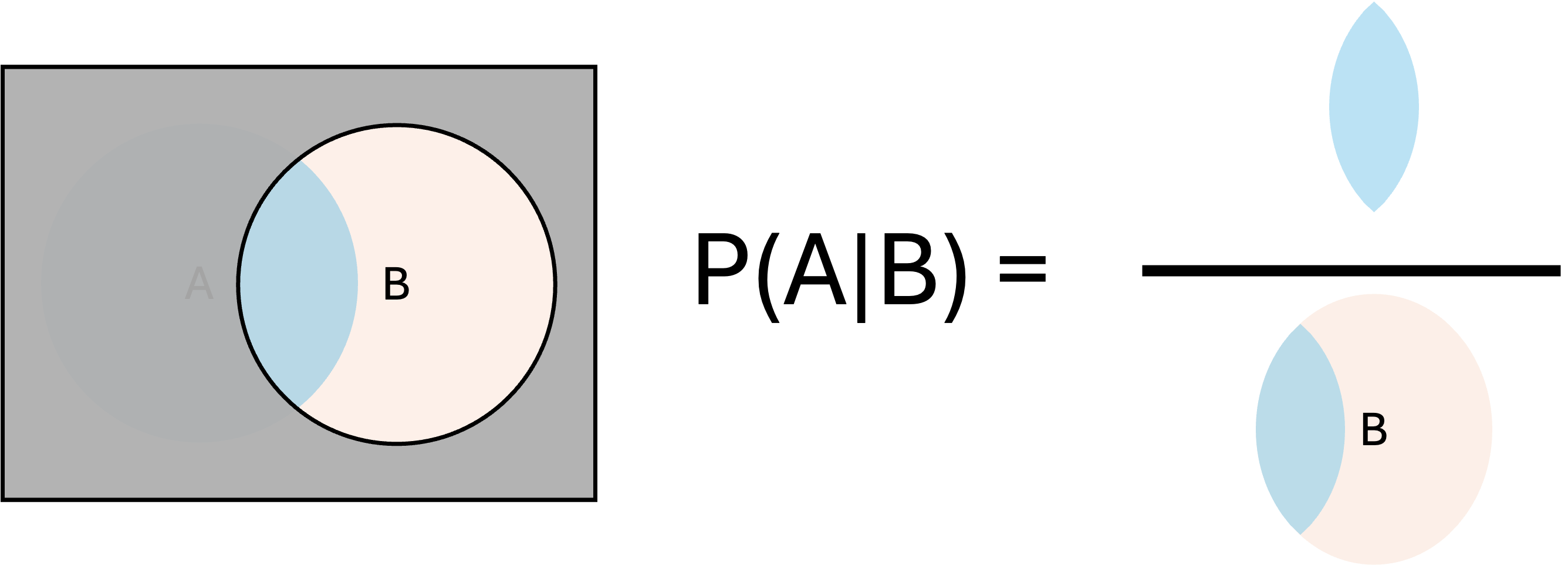
Fig. 4.12 Conditional probability
The numerator of Fig. 4.12 is the Venn diagram representation of \(P(A \cap B)\) and the denominator of \(P(B)\). This graphical expression agrees precisely with the mathematical formula of conditional probability.
Example 💡: Cards from a Deck
Suppse we are drawing a card from a standard deck, where each of the 52 cards has an equal chance of being drawn. Define \(H\) as the event of drawing a heart and \(Q\) as the event of drawing a queen.
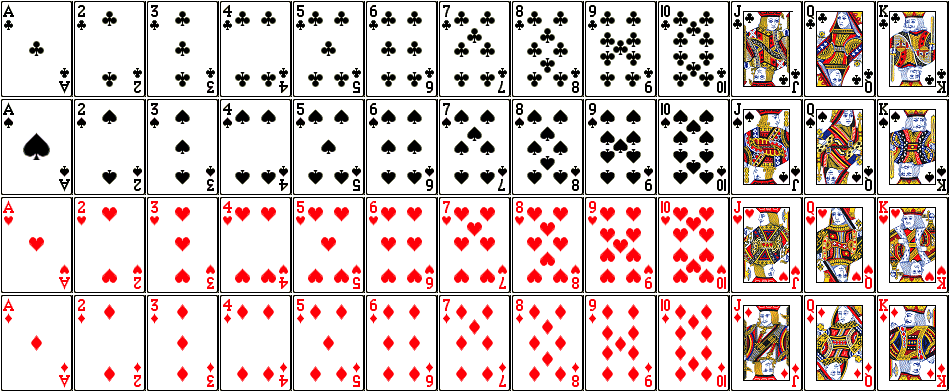
Fig. 4.13 A standard 52-card deck
A card has been drawn. If it is known that the card is a heart, what is the probability that it is a queen?
\(P(Q ∩ H) = 1/52\) (only one card is both a queen and a heart)
\(P(H) = 13/52 = 1/4\) (there are thirteen hearts)
\[P(Q|H) = \frac{P(Q ∩ H)}{P(H)} = \frac{1/52}{13/52} = \frac{1}{13}.\]If it is known that the card is a queen, what is the probability that it is a heart?
\(P(Q) = 4/52 = 1/13\) (there are four queens). Therefore,
\[P(H|Q) = \frac{P(Q ∩ H)}{P(Q)} = \frac{1/52}{1/13} = \frac{1}{4}.\]
🛑 In this example, we computed three closely related two-event probabilities— \(P(Q \cap H), P(Q|H),\) and \(P(H|Q)\)— which yielded different numerical values. It is an important skill to identify which probability a word problem is asking for and then apply the correct formula.
4.3.2. The General Multiplication Rule
The conditional probability formula can be rearranged to give us the general multiplication rule:
This is obtained simply by mupltiplying \(P(B)\) on both sides of the conditional probability formula. This rule allows us to find the probability of the intersection of two events when we know a conditional probability and an unconditional probability.
The formula can also be written as:
Both forms are valid, and which one to use depends on what information is available in a problem.
Extending the General Multiplication Rule to Multiple Events
Begin by taking an unconditioned probability of any one event.
Multiply the probability of a new event conditional on the event used for step 1.
Multiply the probability of another new event conditional on the intersection of all previously used events.
Continue in a similar manner.
The order of events does not influence the outcome. Therefore, for three events \(A, B,\) and \(C\), there are six different ways to apply the general multiplication rule.
4.3.3. Tree Diagrams
Tree diagrams provide a visual tool for organizing and calculating probabilities in multi-stage experiments, especially when conditional probabilities are involved.
Constructing a Tree Diagram

Fig. 4.14 A general tree diagram; the superscript \(^c\) is another notation for complement.
A tree diagram is constructed using the following rules:
A. Layers
The different stages are organized into vertical layers. The first vertical layer describes all events that happen during the first stage. The second layer describe all events that happen in the second stage, and the process is repeated if there are more than two stages.
B. Nodes
Each node represents an event conditional on all previous nodes. Since the first layer does not have any previous node, this is the only layer which involves unconditional events.
C. Branches
The set of branches stemming from a single node must cover all scenarios that can happen given the previous path of nodes. On each branch leading to a node, we write the conditional probability of that node given all previous nodes.
Why is a Tree Diagram Convenient?
It provides a comprehensive picture of an experiment with many components.
It allows us to view the general multiplication rule graphically, since the probability of a path can be computed by multiplying all the conditional probabilities along the path.
In a two-layer tree diagram, for example, \(P(A' \cap B')\) can be computed by
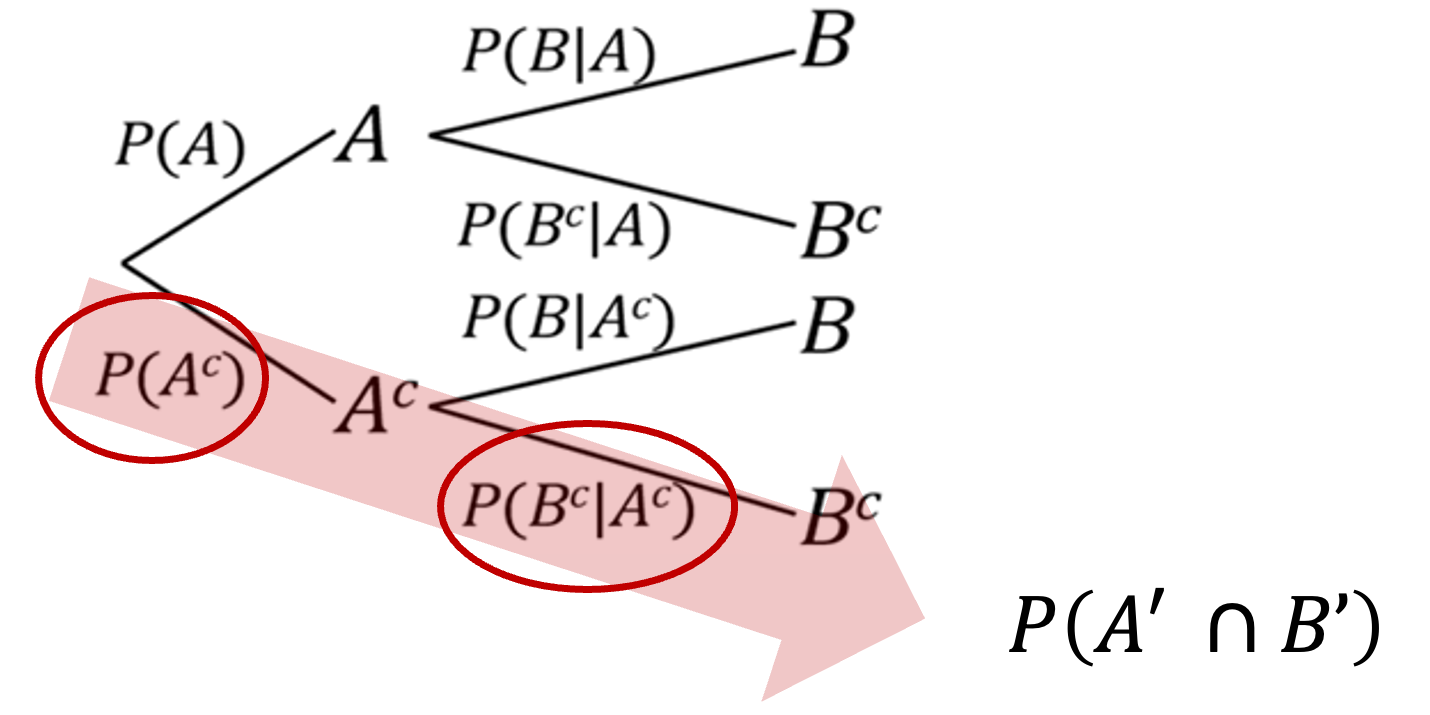
Fig. 4.15 Computing a path probability using a tree diagram
Tree diagrams will also play a crucial role in illustrating important concepts such as the law of total probability in the following sections.
Example💡: Drawing a Tree Diagram
Glen and Jia are going to Indianapolis for one day this weekend. They are twice as likely to go on Sunday as they are on Friday, and three times as likely to go on Saturday as they are on Friday. There is a 45% chance of rain on Friday, a 25% chance of rain on Saturday, and a 30% chance of rain on Sunday.
Draw a complete tree diagram to represent this situation.
Step 1: Define the notation
\(Fri, Sat, Sun\): events representing which day they go to Indianapolis
\(R\): the event that it rains during their trip
\(R'\): the event that it does not rain during their trip
Step 2: Find the unknown probabilities
Given that they are twice as likely to go on Sunday as on Friday, and three times as likely to go on Saturday as on Friday, we can write:
\[P(Sun) = 2P(Fri) \hspace{0.2cm}\text{ and }\hspace{0.2cm} P(Sat) = 3P(Fri).\]Since they will go on exactly one of the three days:
\[\begin{split}1 &= P(Fri) + P(Sat) + P(Sun) \\ &= P(Fri) + 3P(Fri) + 2P(Fri) = 6P(Fri)\\\end{split}\]Therefore, \(P(Fri) = 1/6\), and
\[P(Sat) = 3P(Fri) = 1/2 \hspace{0.2cm}\text{ and }\hspace{0.2cm} P(Sun) = 2P(Fri) = 1/3.\]Step 3: Organize other building blocks
We know the conditional probabilities from the weather forecasts.
\[\begin{split}P(R|Fri) &= 0.45 \\ P(R|Sat) &= 0.25 \\ P(R|Sun) &= 0.30\end{split}\]Using the complement rule, we can also find:
\[\begin{split}P(R'|Fri) = 1 - P(R|Fri)&= 0.55 \\ P(R'|Sat) = 1 - P(R|Sat)&= 0.75 \\ P(R'|Sun) = 1 - P(R|Sun)&= 0.70\end{split}\]Step 4: Draw the diagram
The set of events for which we do not have any conditional probabilities should go in the first layer.
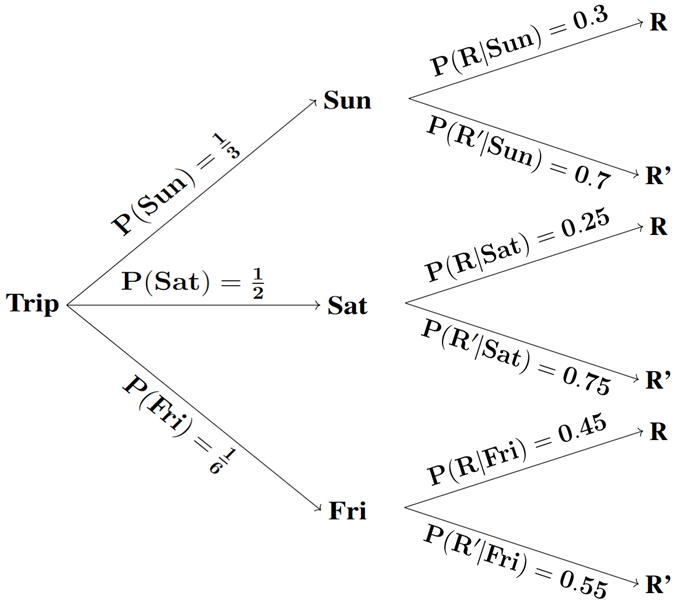
Fig. 4.16 The tree diagram for the Indianapolis problem
Find the probability that they go to Indianapolis on Sunday and it does not rain.
\[P(R' \cap Sun) = P(Sun)P(R'|Sun) = (1/3)(0.70) = 7/30.\]
4.3.4. Bringing It All Together
Key Takeaways 📝
Conditional probability \(P(A|B)\) represents the probability of event A occurring, given that event B occurs, and is calculated as \(P(A ∩ B)/P(B)\).
When we condition on an event \(B\), we effectively restrict our sample space to only the outcomes in \(B\), creating a new probability measure within this reduced space.
The general multiplication rule \(P(A \cap B) = P(A|B) P(B)\) allows us to find the probability of intersections using conditional probabilities.
Tree diagrams provide a systematic way to organize and calculate probabilities in multi-stage experiments, with the probability of each path found by multiplying conditional probabilities along branches.
When solving conditional probability problems, clearly define the events, identify what is known, and determine what needs to be calculated before applying the appropriate formulas.
Exercises
Basic Calculation: A survey found that 70% of students attend morning classes, 80% attend afternoon classes, and 60% attend both morning and afternoon classes. If a student is selected at random:
What is the probability that the student attends afternoon classes given that they attend morning classes?
What is the probability that the student attends morning classes given that they attend afternoon classes?
Card Problems: A card is drawn from a standard 52-card deck. Calculate:
The probability that the card is a king, given that it is a face card.
The probability that the card is a heart, given that it is red.
The probability that the card is a red king, given that it is a king.
Tree Diagram Application: A bag contains 4 red, 3 blue, and 2 green marbles. Two marbles are drawn without replacement.
Draw a tree diagram representing this experiment.
What is the probability that both marbles are the same color?